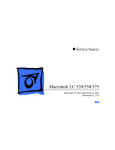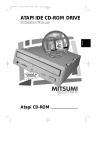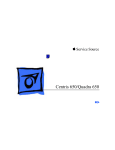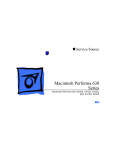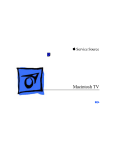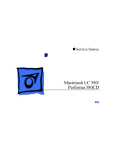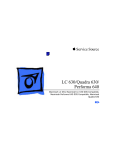Download Apple LC520 Specifications
Transcript
K Service Source Macintosh LC 520/550/575 Macintosh LC 520, Macintosh LC 550, Macintosh LC 575 Service Source Basics Macintosh LC 520, 550, 575 Basics Overview - 1 Overview This manual includes complete repair procedures for the LC 520, LC 550, and LC 575, shown at left. Figure: Macintosh LC 520, LC 550, LC 575 Basics Product Information - 2 Product Information Identifying Features The LC 575 logic board includes a 68LC040 processor, an additional communications slot, and a new hook-and-loopattached battery. The LC 520 and LC 550 do not include these features. The LC 550 and LC 575 ship with • the newer manual-inject 1.4 MB Apple SuperDrive and require the keyhole-shaped bezel. • a revised chassis harness assembly that does not use a floppy drive adapter • the newer, caddyless CD 300+ CD ROM drive Basics Product Information - 3 Compatibility Notes You can exchange the chassis harness assembly of the LC 520 or LC 550 with the newer chassis harness assembly of the LC 575. The newer chassis harness assembly requires the manual-inject floppy drive and caddyless CD ROM drive. K Service Source Specifications Macintosh LC 520, 550, 575 Specifications Processor - 1 Processor LC 520 LC 550 LC 575 Coprocessor Motorola 68030 microprocessor 25 MHz Built-in memory management unit (MMU) Motorola 68030 microprocessor 33 MHz Built-in MMU Motorola 68LC040 microprocessor 33 MHz Built-in MMU Socket for optional math coprocessor Specifications Memory - 2 Memory RAM 4 MB of dynamic RAM on board Expandable to 36 MB (100 ns or faster SIMMs) 72-pin DRAM SIMM connector ROM 1 MB of ROM PRAM 256 bytes of clock/calendar/parameter memory Long-life lithium battery Specifications VRAM Memory - 3 512K of VRAM on board (displays up to 256 colors or 8-bit color) Expandable to I MB (displays up to 32,000 colors or 16-bit color) 68-pin VRAM SIMM connector (LC 520) Two VRAM SIMM slots (LC 575) Specifications Disk Storage - 4 Disk Storage Floppy Drive Internal 1.4 MB Apple SuperDrive, auto-inject (LC 520) Internal 1.4 MB Apple SuperDrive, manual-inject (LC 550 and LC 575) Hard Drive 3.5-inch, internal 80, 160, 250, or 320 MB SCSI hard drive CD-ROM Drive Internal Apple CD 300i CD-ROM drive (LC 520) Internal Apple CD 300+ CD-ROM drive (LC 550 and LC 575) Specifications I/O Interfaces - 5 I/O Interfaces Serial Two RS-232/RS-422 serial ports; mini DIN-8 connectors SCSI One SCSI parallel port; DB-25 connector Connects up to six external SCSI devices Apple Desktop Bus Processor-Direct Slot Two Apple Desktop Bus (ADB) ports; mini DIN-4 connectors Maximum of three ADB devices recommended Maximum current draw: 500 mA (Mouse draws 10 mA; keyboard draws 25 mA.) Internal expansion slot for 96 or 114-pin processor-direct expansion cards Specifications Communications Slot (LC 575) Sound I/O Interfaces - 6 Internal expansion for 50-pin modem and Ethernet cards Sound-output port capable of delivering stereo sound Sound-input port for monaural sound input Front headphone jack capable of delivering stereo sound Specifications I/O Devices - 7 I/O Devices Keyboard Standard 80-key Apple keyboard with numeric keypad; ADB connector Soft power-on switch 2.5 mm travel, 18 mm vertical and horizontal pitch Two-level tilt adjustment Mouse Apple Desktop Bus Mouse II New, ergonomic design Microphone Built-in electret, omnidirectional microphone Speaker Adjustable sound control on front of bezel Specifications Sound and Video - 8 Sound and Video Sound Generator Video Display Records at 11 kHz or 22 kHz sample rate Plays back at 22 kHz sample rate Two speakers with enhanced stereo sound Allows playback and recording of ordinary audio compact discs 14-in. diagonal, 13-in. viewable screen Trinitron CRT with high-contrast glass .26-mm aperture grille pitch 640 pixels by 480 lines; 70 dpi Specifications Electrical - 9 Electrical Line Voltage 100–240 VAC; Universal power supply Frequency 47–63 Hz, single phase Maximum Power 120 W Specifications Physical - 10 Physical Dimensions Weight Height: 17.9 in. (45.5 cm) Width: 13.5 in. (34.4 cm) Depth: 16.5 in. (42.0 cm) 40.5 lb. (18.4 kg) Specifications Environmental - 11 Environmental Operating Temperature Storage Temperature 50–104° F (10–40° C) -40 to 149° F (-40 to 65° C) Relative Humidity 20–95% noncondensing Altitude 0–10,000 ft. (operating) K Service Source Troubleshooting Macintosh LC 520, 550, 575 Troubleshooting General/ - 1 General The Symptom Charts included in this chapter will help you diagnose specific symptoms related to your product. Because cures are listed on the charts in the order of most likely solution, try the first cure first. Verify whether or not the product continues to exhibit the symptom. If the symptom persists, try the next cure. (Note: If you have replaced a module, reinstall the original module before you proceed to the next cure.) If you are not sure what the problem is, or if the Symptom Charts do not resolve the problem, refer to the Flowchart for the product family. For additional assistance, contact Apple Technical Support. Troubleshooting Symptom Charts/Video - 2 Symptom Charts Video Screen is black, too dark, or too bright; audio and drive operate 1 2 3 4 5 6 7 Screen is bright and audio is present, but no video information is visible 1 2 3 Adjust contrast button on front bezel. Adjust brightness. Use Screen Control Panel. Check yoke cable connection. Perform video adjustments. Refer to “Video” in Adjustments chapter. Perform battery verification. Replace analog board. Replace CRT. Perform video adjustments. Refer to “Video” in Adjustments chapter. Replace analog board. Replace CRT. Troubleshooting Symptom Charts/Video (Continued) - 3 Video Single vertical or horizontal line is displayed (Continued) Note: A thin, gray, horizontal line may be visible across the bottom third of a lit screen. This line is inherent in the design of Trinitron monitors. Do not replace modules. Otherwise, 1 2 Replace analog board. Replace CRT. Predominant color tint or color cannot be adjusted 1 Perform video adjustments. Refer to “Video” in Adjustments chapter. Replace analog board. Replace CRT if red, green, or blue cannot be turned off using appropriate controls. Black screen spots (burnt phosphors) Replace CRT. 2 3 Troubleshooting Symptom Charts/Video (Continued) - 4 Video (Continued) Picture breaks into diagonal lines, or picture rolls vertically or horizontally 1 Out of convergence (color bleeds from text or lines) 1 Flashing or wavy screen or monitor emits high-pitched noise Replace analog board. 2 2 3 Perform video adjustments. Refer to “Video” in Adjustments chapter. Replace analog board. Perform convergence adjustment. Refer to “Convergence” in Adjustments chapter. Replace analog board. Replace CRT. Troubleshooting Symptom Charts/Video (Continued) - 5 Video Screen jitters or flashes 1 2 3 4 (Continued) Verify that adjacent computer equipment is properly grounded. Move electrical devices away from monitor. Temporarily shut off all fluorescent lights in area. Check that all ground cables are secure. Disconnect internal floppy drive, CD-ROM drive, and hard drive. Replace analog board. Out of focus 1 2 3 Perform focus adjustment. Refer to “Focus” in Adjustments. Replace analog board. Replace CRT only if one part of display remains out of focus despite adjustment of focus controls to their limits. Raster size too short/ tall or narrow/wide 1 Adjust horizontal or vertical size control. Refer to Adjustments chapter. Replace analog board. 2 Troubleshooting Symptom Charts/Video (Continued) - 6 Video Linearity bad (size of text/graphics differs at top, bottom, or sides of screen) 1 Raster tilted or shifted 1 2 2 3 4 (Continued) Perform video adjustments. Refer to “Video” in Adjustments chapter. Replace analog board. Verify that adjacent computer equipment is properly grounded. Move electrical devices away from monitor. Temporarily shut off all fluorescent lights in area. Perform appropriate geometric adjustments. Refer to Adjustments chapter. Perform yoke adjustment. Refer to “Yoke” in Adjustments chapter. Replace analog board. Troubleshooting Symptom Charts/Video (Continued) - 7 Video Raster not centered 1 2 3 Raster distorted (barrel-shaped, corners not square, stretched or compressed at top of display, or sides not perpendicular) 1 2 3 4 (Continued) Verify that adjacent computer equipment is properly grounded. Move electrical devices away from monitor. Temporarily shut off all fluorescent lights in area. Adjust horizontal or vertical center control. Refer to Adjustments chapter. Replace analog board. Verify that adjacent computer equipment is properly grounded. Move electrical devices away from monitor. Temporarily shut off all fluorescent lights in area. Perform appropriate geometric adjustments. Refer to Adjustments chapter. Replace analog board. Replace CRT (only in rare instances). Troubleshooting Symptom Charts/Floppy Drive - 8 Floppy Drive Audio and video are present, but internal floppy drive does not operate 1 2 3 4 5 Replace bad disk with known-good disk. Replace floppy drive. Replace logic board. Retain customer’s SIMMs. Replace floppy drive. Replace chassis harness cable. Disk ejects; display shows icon with blinking “X” 1 2 3 4 Replace bad system disk with known-good system disk. Replace floppy drive. Replace logic board. Retain customer’s SIMMs. Replace chassis harness cable. Troubleshooting Symptom Charts/Floppy Drive (Continued) - 9 Floppy Drive Does not eject disk Internal floppy drive runs continuously 1 2 (Continued) 3 4 Insert opened paper clip into hole beside floppy drive. Switch off system and hold mouse button down while switching system on (to complete eject cycle). Remove front drive bezel. Replace floppy drive. 1 2 3 4 5 Replace bad disk with known-good disk. Replace floppy drive. Replace logic board. Retain customer’s SIMMs. Replace floppy drive. Replace chassis harness cable. Troubleshooting Symptom Charts/Floppy Drive (Continued) - 10 Floppy Drive Unable to insert disk all the way 1 2 3 4 (Continued) To eject previously inserted disk, insert opened paper clip into hole beside floppy drive. Switch off system and hold mouse button down while switching system on (to complete eject cycle). Remove front drive bezel. Replace floppy drive. Troubleshooting Symptom Charts/Hard Drive - 11 Hard Drive Internal or external hard drive does not operate 1 2 3 4 5 6 Verify that SCSI loopback card is not attached. Verify that external drive is properly terminated. Replace hard drive. Replace logic board. Retain customer’s SIMMs. Replace hard drive. Replace chassis harness cable. Works with internal or external SCSI device but does not work with both 1 Verify that SCSI device ID switch setting on external device is higher than 0. Also verify that ID switch setting on external SCSI device does not duplicate ID switch settings on any other attached external SCSI devices. Replace terminator on external SCSI device. Replace SCSI select cable. 2 3 Troubleshooting Symptom Charts/CD-ROM Drive - 12 CD-ROM Drive CD-ROM drive does not accept disc 1 2 3 Replace disc (if dirty or damaged). Remove front drive bezel. Replace CD-ROM drive mechanism. Volume control does not operate correctly 1 2 Reset PRAM. Replace chassis harness assembly. Macintosh cannot mount CD-ROM drive 1 2 Verify proper CD-ROM software is installed. Start up from known-good system, Disk Tools, or external SCSI device. Replace CD-ROM drive mechanism. 3 Troubleshooting Symptom Charts/Peripheral - 13 Peripheral Cursor does not move Cursor moves, but clicking mouse button has no effect 1 2 3 4 5 6 Check mouse connection. If mouse was connected to keyboard, connect it to rear ADB port instead. If mouse works, replace keyboard. If mouse does not work in any ADB port, replace mouse. Reset PRAM. Remove additional PDS and CS cards. Replace logic board. Retain customer’s SIMMs. 1 2 Replace mouse. Replace logic board. Retain customer’s SIMMs. Troubleshooting Symptom Charts/Peripheral (Continued) - 14 Peripheral Cannot double-click to open application, disk, or server 1 2 4 5 Remove extra system files on hard drive. Clear parameter RAM. Hold down <Command> <Option> <P> <R> keys during system startup but before “Welcome to Macintosh” appears. If mouse was connected to keyboard, connect it to rear ADB port instead. If mouse works, replace keyboard. If mouse does not work in any ADB port, replace mouse. Replace logic board. Retain customer’s SIMMs. 1 2 3 4 5 Check keyboard connection to ADB port. Replace keyboard cable. Replace keyboard. Reset PRAM. Replace logic board. Retain customer’s SIMMs. 3 No response to any key on keyboard (Continued) Troubleshooting Symptom Charts/Peripheral (Continued) - 15 Peripheral Known-good ImageWriter or ImageWriter II does not print 1 2 Known-good LaserWriter does not print 1 2 3 4 5 3 4 (Continued) Make sure that Chooser and Control Panel are set correctly. Replace printer driver and system software with knowngood. Reset PRAM. Replace printer interface cable. Replace logic board. Retain customer’s SIMMs. Make sure that Chooser and Control Panel are set correctly. Replace printer driver and system software with knowngood. Reset PRAM. Refer to Networks and Communications manual. Troubleshooting Symptom Charts/Miscellaneous - 16 Miscellaneous Clicking, chirping, or thumping sound 1 2 Replace analog board. Replace logic board. Retain customer’s SIMMs. Smoke/odor 1 2 Inspect analog board and logic board for any signs of burnt components. Replace analog board. 1 2 3 4 5 6 Connect power cord. Switch power on. Replace power cord. Replace keyboard. Replace analog board. Replace logic board. Retain customer’s SIMMs. No video, no audio, and no drive operation Troubleshooting Symptom Charts/Miscellaneous (Continued) - 17 Miscellaneous (Continued) Screen shows “Sad Macintosh” icon and black vertical lines; screeching sound 1 2 Replace RAM SIMMs on logic board. Replace logic board. Retain customer’s SIMMs. Headphone jack does not operate correctly 1 2 Verify that headphone jack is seated properly. Replace chassis harness assembly. Speaker jacks do not operate 1 2 Verify that speaker jacks are seated properly. Replace logic board. System automatically restarts after shutdown Check whether test jumper is installed on analog board (location: BD 11). If it is installed, remove it. Troubleshooting Symptom Charts/Miscellaneous (Continued) - 18 Miscellaneous “Sad Macintosh” icon 1 2 3 4 (Continued) Replace bad disk with known-good disk. Disconnect internal and external IDE or SCSI devices. If the flashing “?” appears, re-attach devices one at a time. Troubleshoot software issue on device that produces problem. Replace RAM SIMMs on logic board. Replace logic board. Retain customer’s SIMMs. K Service Source Take Apart Macintosh LC 520, 550, 575 Take Apart Rear Housing Rear Housing - 1 Rear Housing No preliminary steps are required before you begin this procedure. Warning: This product contains high voltage and a high-vacuum picture tube. To prevent serious injury, review CRT safety in Bulletins/Safety. ± Never use a grounding wriststrap until after discharging the CRT. ±Warning: Take Apart Rear Housing - 2 Note: If the rear cover has bronze tape on the rear cover shield, remove the tape before removing the rear cover. Bend back the center ground pin on the rear cover shield about 1/8 inch. Do not replace the bronze tape. Center Ground Pin Take Apart Rear Housing Rear Housing - 3 1 2 Using a Torx screwdriver, remove the five screws. Lift off the rear cover. Take Apart Fan - 4 Fan Fan Before you begin, remove the rear cover. This product contains high voltage and a high-vacuum picture tube. To prevent serious injury, review CRT safety in Bulletins/Safety. ±Warning: Warning: Never use a grounding wriststrap until after discharging the CRT. ± Take Apart Fan - 5 P ush out the two latches and remove the fan assembly. Latch Latch Fan Take Apart Analog Board - 6 Analog Board Before you begin, • Remove the rear cover • Discharge the CRT • Remove the anode cap Analog Board This product contains high voltage and a high-vacuum picture tube. To prevent serious injury, review CRT safety in Bulletins/Safety. ±Warning: Warning: Never use a grounding wriststrap until after discharging the CRT. ± Take Apart Analog Board - 7 Degauss Panel Ground Cable Ground Cable 1 Disconnect the two ground cables from the degauss panels. Take Apart Analog Board - 8 2 Internal Microphone Connector WARNING: High Voltage Areas Disconnect the internal microphone connector. Take Apart Analog Board - 9 3 Cable Retainer 4 Disconnect the following cables from the analog board: • Degauss cable from BP2 (use a small screwdriver to release the latch) • CRT cable from BD1 Remove the wires from the cable retainer. Replacement Note: If you are replacing the analog board, remove the cable retainer and reinstall it on the new board. Take Apart Analog Board - 10 5 CRT Board Assembly Caution: Twisting, bending, or applying force to the video board assembly could damage the neck of the CRT. Be sure to pull the CRT board assembly straight off the CRT. Remove the CRT board assembly from the neck of the CRT. Take Apart Analog Board - 11 6 Analog Board Remove the analog board. Replacement Note: Some analog boards may include a test jumper (located at BD 11). To avoid restart problems, remove this jumper from the existing or replacement analog board. Replacement Note: Perform the cutoff adjustment whenever you replace the analog board. See “Video” in the Adjustments chapter. Take Apart I/O Door - 12 I/O Door No preliminary steps are required before you begin this procedure. I/O Door Caution: Review the ESD precautions in Bulletins/ Safety. Take Apart I/O Door - 13 1 2 Tab Tab I/O Door Remove the two screws. Push down on the two tabs and remove the I/O door. Take Apart Logic Board - 14 Logic Board Before you begin, remove the I/O door. Logic Board Caution: You can access and remove the LC 520 logic board merely by removing the I/O door at the rear of the machine. Although upgrading the logic board is now extremely easy, do not neglect to follow proper ESD precautions: use a grounded workbench pad, and always wear a grounding wriststrap. Take Apart Logic Board - 15 Pull out the logic board. Logic Board Take Apart Drive Bezel - 16 Drive Bezel No preliminary steps are required before you begin this procedure. Caution: Review the ESD precautions in Bulletins/ Safety. Drive Bezel Take Apart Drive Bezel - 17 Using a flat-blade screwdriver, push up the latch. Pull down and remove the drive bezel. Latch Drive Bezel Take Apart Floppy Drive - 18 Floppy Drive Before you begin, remove the drive bezel. Floppy Drive Caution: You can access and remove the floppy drive merely by removing the drive bezel at the front of the machine. Although replacing the floppy drive is now extremely easy, do not neglect to follow proper ESD precautions: use a grounded workbench pad, and always wear a grounding wriststrap. Take Apart Floppy Drive - 19 Note: The LC 520 includes an auto-inject 1.4 MB floppy drive and a chassis harness assembly that requires a floppy drive connector adapter. The LC 550 and 575 include manual-inject 1.4 MB floppy drives and chassis harness assemblies that allow the floppy drive cable to connect directly to the drive. Take Apart Floppy Drive - 20 Push down the latch and pull out the floppy drive. Floppy Drive Latch Take Apart Connector Adapter (LC 520 Only) Floppy Drive - 21 Macintosh LC 520 Auto-inject Floppy Drive 1 Pull out the floppy drive connector adapter Replacement Note: Be sure to reinstall the floppy drive connector adapter on the replacement floppy drive. Take Apart Floppy Drive - 22 Auto-inject Floppy Drive and Shield Auto-inject Floppy Drive Carrier 2 Remove the four mounting screws and remove the floppy drive from the carrier. Take Apart Floppy Drive - 23 3 Auto-inject Floppy Drive Shield Auto-inject Floppy Drive Pull out the sides of the floppy drive shield, lift the back of the shield, and remove it from the floppy drive. Take Apart Floppy Drive - 24 Manual-Inject Floppy Drive Macintosh LC 550 and 575 Manual-inject Floppy Drive Remove the four mounting screws and remove the floppy drive from the carrier. Note: Do not remove the metal case from the manualinsert floppy drive in the LC 550 and LC 575. Manual-inject Floppy Drive Take Apart CD-ROM Drive - 25 CD-ROM Drive Before you begin, remove the drive bezel. Caution: You can access and remove the CD-ROM drive merely by removing the drive bezel at the front of the machine. Although upgrading the CD-ROM drive is now extremely easy, do not neglect to follow proper ESD precautions: use a grounded workbench pad, and always wear a grounding wriststrap. CD-ROM Drive Take Apart CD-ROM Drive - 26 1 CD-ROM Drive Latch Pull up the latch and pull out the CD-ROM drive. Take Apart CD-ROM Drive - 27 2 CD Connector or Hard Drive Adapter CD Audio Adapter Pull out the CD connector adapter and the CD audio adapter. Replacement Note: Be sure to reinstall the CD connector adapter on the replacement CD-ROM drive. Take Apart CD-ROM Drive - 28 Replacement Note: Be sure to reinstall the correct drive connector adapter and CD audio adapter. The adapters used for the LC 520 and LC 575 are very similar, but are not interchangeable. The bases of the LC 520 adapters are shorter than the bases of the LC 575 adapters. Take Apart CD-ROM Drive - 29 3 CD-ROM Drive Carrier Remove the four mounting screws and remove the CD-ROM drive from the carrier. Replacement Note: Replace the carrier on the new CDROM drive. Take Apart Hard Drive - 30 Hard Drive Before you begin, remove the I/O door. Hard Drive Caution: You can access and remove the LC 520 hard drive merely by removing the I/O door at the rear of the machine. Although upgrading the hard drive is now extremely easy, do not neglect to follow proper ESD precautions: use a grounded workbench pad, and always wear a grounding wriststrap. Take Apart Hard Drive - 31 1 Hard Drive Latch Push down the latch and remove the hard drive. Take Apart Hard Drive - 32 2 Pull out the hard drive connector adapter. Replacement Note: Be sure to reinstall the hard drive connector adapter on the replacement hard drive. Hard Drive Connector Adapter Take Apart Hard Drive - 33 3 4 Carrier Hard Drive Remove the four screws. Remove the hard drive from the carrier. Replacement Note: Replace the carrier on the new hard drive. Take Apart Chassis Harness Assembly - 34 Chassis Harness Assembly Before you begin, remove the following: • Drive bezel • I/O door • CD-ROM drive • Floppy drive • Hard drive • Logic board • Rear housing • Analog board Chassis Harness Assembly Take Apart Chassis Harness Assembly - 35 This product contains high voltage and a high-vacuum picture tube. To prevent serious personal injury or equipment damage, review CRT safety in Bulletins/Safety. ±Warning: Chassis Harness Assembly Latches Never use a grounding wriststrap until after discharging the CRT. ±Warning: 1 Latches 2 Discharge the CRT. Press in the four latches and lift off the chassis harness assembly. Take Apart Chassis Harness Assembly - 36 Chassis Harness Take Apart Strategy Background After product introduction, Apple Service adjusted the service strategy for the chassis harness assembly in Mac TV, LC 500 Series, and Performa 500 Series computers. Originally, the chassis harness assembly was a single service assembly. As of November 1994, the chassis harness assembly is divided into several service piece parts. Identifying the Chassis Harness Assembly There are three slightly different chassis harness assemblies and Apple service strategy varies with the type of chassis. The three chassis harness assemblies differ according to the combination of floppy and CD-ROM drives they support. Take Apart Chassis Harness Assembly - 37 • Chassis 922-1824 supports the auto-insert Apple SuperDrive and CD-ROM drives earlier than the 300i+. This chassis requires a floppy drive adapter, and the CDROM connector bridge is about 1-1/2 inches above the CD-ROM drive bay. • Chassis 922-0557 supports the manual-insert Apple SuperDrive and CD-ROM drives earlier than the 300i+. This chassis uses a ribbon cable to connect the floppy drive, and the CD-ROM connector bridge is about 1-1/2 inches above the CD-ROM drive bay. • Chassis 661-1094 supports the manual-insert Apple SuperDrive and the 300i+ CD-ROM drive. This chassis uses a ribbon cable to connect the floppy drive, but the CD-ROM connector bridge is only 1/2 inch above the CDROM drive bay. Take Apart Chassis Harness Assembly - 38 For more information, refer to Apple Service Guide, Macintosh Computers, Vol. 3 (1994), page 110. Service Parts Now Available for Chassis 922-1824 and 922-0557 661-0981 Shield Kit (EMI shielding) 922-1825 PCBA Front Panel (front panel control board) 922-1826 Speaker Assembly (speaker and wire) 922-0117 Screw 076-0489 Chassis Kit (bare chassis) 922-0503 FoxConn Cable Assembly (logic board connector and cable assembly) Take Apart Chassis Harness Assembly - 39 Service Parts Now Available for Chassis 661-1094 661-0981 Shield Kit (EMI shielding) 922-1825 PCBA Front Panel (front panel control board) 922-1826 Speaker Assembly (speaker and wire) 922-0117 Screw Take Apart Chassis Harness Assembly - 40 Chassis Harness Take Apart Procedures First remove the chassis harness assembly. EMI Shields 1 2 Remove the EMI shields in this order: lower shield, front drive and speaker shield, top panel shield. Remove the front panel control board shield if it is present. Take Apart Chassis Harness Assembly - 41 Speaker Assembly First remove the EMI shields. Caution: The speaker wire connections on the chassis cable bridge are very fragile. Avoid removing or replacing the speaker wires unless you need to replace the chassis or have isolated the problem to the speaker wires. (That is, replace and test the speakers, front panel control board, and analog board first.) Take Apart Chassis Harness Assembly - 42 1 2 Disconnect the speaker wire spade connector from the back of the speaker. Remove the Phillips screws from the front of the speaker. Replacement Note: Detach the replacement speaker from its wires and connect the replacement speaker to the original speaker wires. Speaker Wires Note: The speaker wire connectors are very fragile. 1 2 Look down on the chassis cable bridge and locate the notches in the cable bridge on top of the wire connectors. Using a jeweler's screwdriver, very gently press down on the tab in the middle of the wire connector. You will feel or hear a snap. Take Apart Chassis Harness Assembly - 43 3 Slide out the wire connector. Replacement Note: The analog board slides into the computer and completes the connection to the speaker wires; thus, the speaker wire connectors must sit securely in the cable bridge. 4 Slide the speaker wire connector into its position in the cable bridge and press up until the connector is secure. You may need to use a jeweler's screw driver to adjust the small metal tab in the center of the speaker wire connector. Take Apart Chassis Harness Assembly - 44 Front Panel Control Board First remove the EMI shields. 1 2 Disconnect the front panel control cable. Remove the Phillips screw and remove the board. Take Apart Chassis Harness Assembly - 45 Logic Board Connector and Cable Assembly First remove the EMI shields, speaker assembly, and front panel control board. Overview of removal procedures (Detailed steps follow the overview.) First disconnect all the connections from the top of the chassis. Then route the cables through to the underside of the chassis and disconnect the logic board connector. Take Apart Chassis Harness Assembly - 46 1 Hard Drive Connector CD-ROM Connector Left Speaker Cable Connector Right Speaker Cable Connector Analog Board Connector Bridge Cable Floppy Drive Connector Stand at the front of the chassis, looking down at the top of the chassis, and disconnect the following in the order listed: analog board connector, CD-ROM drive connector, and hard drive connector. (The connector tabs operate much like largescale SIMM slot connectors on logic boards.) Take Apart Chassis Harness Assembly - 47 2 3 4 5 Route the analog board and the CD-ROM/hard drive cables through the large square hole behind the CD-ROM drive bay. Push the floppy drive cable (if present) and front panel control cable to the underside of the chassis. Turn the chassis over and stand at the rear of the chassis. Release the three tabs from the sides and center of the logic board connector and remove the logic board connector and cable assembly. Take Apart Chassis Harness Assembly - 48 Overview of replacement procedures (Detailed steps follow the overview.) Connect the logic board connector to the underside of the chassis, route the cables through the appropriate openings, and connect the connectors on the top and front of the chassis. After replacing the logic board connector and cable assembly, replace the speakers, front panel control board, and EMI shields. 1 Place the chassis with the underside facing up and the speakers facing away from you. Take Apart Chassis Harness Assembly - 49 2 Analog Board Connector Logic Board Connector CD-ROM Drive Cable/ Hard Drive Cable Control Panel Cable Floppy Drive Cable 3 Arrange the logic board connector and cable assembly as shown. Face the connector slot of the logic board connector toward the rear and from the back of the connector route the CDROM/hard drive, analog, and floppy drive cables under the connector. Extend the control panel connector cable from the back of the logic board connector toward the front of the chassis. Take Apart Chassis Harness Assembly - 50 Logic Board Connector and Cable Assembly 1 2 Slide the side extension of the logic board connector down the front side of the small keyed tabs. The logic board connector will snap into place. Note: Be sure the center tab snaps into place at the same time. Route the front panel control cable through the hole in the front of the chassis Take Apart Chassis Harness Assembly - 51 3 4 5 Route the floppy drive cable through its opening at the back of the floppy drive bay. Carefully route the analog and CD-ROM/hard drive cables through the large opening behind the CD-ROM drive bay Turn over the chassis so that the top is up and the speakers are at the front, facing you. Important: Be sure to reconnect the CD-ROM, hard drive, and analog connectors in the proper order. When you position the CD-ROM, hard drive, and analog connectors, be sure that the power cables are placed toward the outside of the chassis and the data ribbon cables are placed toward the inside of the chassis. 6 7 Locate the CD-ROM, hard drive, and analog connectors. Position the CD-ROM connector with the connector slot Take Apart Chassis Harness Assembly - 52 8 9 facing the front of the chassis and the power cables facing toward the outside edge of the chassis. Slip the connector extension through the slot in the side of the chassis and slide the connector into place. Position the hard drive connector with the connector slot facing the rear of the chassis and the power cables facing toward the outside edge of the chassis. Slip the connector extension through the slot in the side of the chassis and slide the connector into place. Position the analog board connector with the connector slot facing the rear and the power cables facing toward the outside edge of the chassis. You will have to route the cable under the connector (between the connector and the cable bridge). Slightly push forward one of the keyed tabs and slide the connector into place. Take Apart Chassis Harness Assembly - 53 10 To replace the speakers, front control panel board, and EMI shields, reverse the take-apart procedures above. Pay attention to the caution regarding the fragility of the speaker wire connectors and their replacement procedures. Take Apart CRT - 54 CRT CRT Before you begin, remove the following: • Drive bezel • I/O door • CD-ROM drive • Floppy drive • Hard drive • Logic board • Rear cover • Analog board • Chassis harness assembly Take Apart CRT - 55 Mounting Screws Degauss Panel This product contains high voltage and a high-vacuum picture tube. To prevent serious injury, review CRT safety in Bulletins/Safety. ±Warning: Degauss Panel Never use a grounding wriststrap until after discharging the CRT. ±Warning: 1 Remove the four mounting screws and lift off the two degauss panels. Take Apart CRT - 56 2 Lift off the CRT. Replacement Note: Be sure the microphone cable is not caught under the CRT. CRT Microphone Cable Take Apart Internal Microphone - 57 Internal Microphone Internal Microphone Before you begin, remove the following: • Drive bezel • I/O door • CD-ROM drive • Floppy drive • Hard drive • Logic board • Rear cover • Analog board • Chassis harness assembly • CRT Take Apart Internal Microphone - 58 This product contains high voltage and a high-vacuum picture tube. To prevent serious injury, review CRT safety in Bulletins/Safety. Never use a grounding wriststrap until after discharging the CRT. ±Warning: Push out the two latches and remove the internal microphone board and the rubber microphone gasket. Replacement Note: Be sure the rubber gasket is in place before replacing the microphone board. Take Apart Front Bezel - 59 Front Bezel Front Bezel To remove the front bezel, remove the following: • Drive bezel • I/O door • CD-ROM drive • Floppy drive • Hard drive • Logic board • Rear cover • Analog board • Chassis harness assembly • CRT • Internal microphone Take Apart Front Bezel - 60 This product contains high voltage and a high-vacuum picture tube. To prevent serious injury, review CRT safety in Bulletins/Safety. ±Warning: Front Bezel Never use a grounding wriststrap until after discharging the CRT. ±Warning: K Service Source Upgrades Macintosh LC 520, 550, 575 Upgrades Macintosh Processor Upgrade - 1 Macintosh Processor Upgrade (including 256K Cache Card) Macintosh Processor Upgrade Before you begin, remove the following: • I/O door • Logic board • Card in PDS slot (if any) Caution: Review the ESD precautions in Bulletins/ Safety. Upgrades Macintosh Processor Upgrade - 2 Note: The Macintosh Processor Upgrade kit allows 68LC040 computers to switch between a PowerPC 601 processor and a 68LC040 processor. The upgrade board includes the PowerPC 601 processor on board and a socket to accept the customer’s 68LC040 processor. Upgrades Macintosh Processor Upgrade - 3 Note: The PowerPC upgrade for the Macintosh LC 520 and 550 consists of a Macintosh LC 575 logic board, the PowerPC Upgrade Card, a new rear panel, and the 575 product ID label. To install this upgrade, follow the Macintosh LC 575 PowerPC Upgrade procedures in this topic, substituting the 575 logic board, rear panel, and ID label for those installed on the Macintosh LC 520 and 550. Upgrades Macintosh Processor Upgrade - 4 Note: Refer to the Macintosh Processor Upgrade manual for information about specifications and troubleshooting. Upgrades Macintosh Processor Upgrade - 5 Macintosh Processor Hook-and-Loop Upgrade with 256K Cache Card Fasteners 040 Heat Sink 256K Cache Card Spacer Processor Removal Tool Note: The Macintosh Processor Upgrade comes packaged with the Macintosh Processor Upgrade board, 256K cache card, 040 heat sink, and hook-and-loop fasteners. If you need to order service replacement parts, order the parts separately. Note: To install the upgrade, you will need a processor removal tool. Order the removal tool as a separate service part. Upgrades Macintosh Processor Upgrade - 6 Note: The cache card comes installed on the upgrade board. Upgrades Macintosh Processor Upgrade - 7 Installation Procedure Overview These are the basic steps to installing the Macintosh Processor Upgrade. • Remove the 68LC040 processor from the customer’s logic board • Install the 68LC040 processor on the upgrade board • Prepare the upgrade and logic boards for installation • Install the upgrade board on the logic board Upgrades Macintosh Processor Upgrade - 8 • Reinstall the cache card on the upgrade board Detailed procedures follow. Upgrades Macintosh Processor Upgrade - 9 Remove the 68LC040 Processor from the Logic Board 1 68LC040 Processor Locate the 68LC040 processor on the logic board. Upgrades Macintosh Processor Upgrade - 10 Processor Processor 2 Position the teeth of the processor removal tool in the groove between the processor and the logic board socket. Caution: Be sure to lift up on the handle of the processor removal tool. Pressing down could damage components on the logic board. Processor Removal Tool Logic Board Socket Upgrades Macintosh Processor Upgrade - 11 Processor Processor Note: This graphic shows the proper way to remove a 68LC040 chip from its logic board. Your logic board may differ somewhat from this graphic. 3 Processor Removal Tool Logic Board Socket 4 Caution: Pry up each side of the processor only slightly to avoid bending the pins. Gently lift up the processor removal tool handle and pry up each side of the processor from the socket. Remove the processor. Upgrades Macintosh Processor Upgrade - 12 Spacer Install the 68LC040 Processor on the Upgrade Board Note: The alignment corner of the 68LC040 processor is missing one pin. The alignment corner of the spacer is missing a pin hole. 1 Alignment Corners 68LC040 Processor 2 Position the spacer alignment corner over the 68LC040 processor alignment corner Place the spacer on the processor. Upgrades Macintosh Processor Upgrade - 13 Caution: Forcing the 68LC040 processor connector pins into the socket could damage the pins. If the processor resists installation, check the pin alignment. 68LC040 Processor Caution: Place the upgrade board on a firm even surface to avoid bending the upgrade board when pressing the processor into the socket. Caution: Use two thumbs to evenly distribute the pressure as you press the processor into the socket. Upgrades Macintosh Processor Upgrade - 14 3 4 Hold the processor and spacer together and position the spacer alignment corner over the upgrade socket alignment corner. Press the processor connector pins into the socket until you hear a “snap.” Upgrades Macintosh Processor Upgrade - 15 Note: On a correctly installed 040 processor, a very small gap separates the 040 chip from the metal spacer. A larger gap caused by the barrel sockets of the upgrade board separates the upgrade board and the spacer. 040 Processor Small Gap Barrel Sockets Spacer Upgrades Macintosh Processor Upgrade - 16 Prepare the Upgrade and Logic Boards for Installation Note: The following steps explain how to prepare the upgrade board and logic board to connect with each other. 1 Upgrade Board 256K Cache Card Remove the 256K cache card from the upgrade board. Upgrades Macintosh Processor Upgrade - 17 Note: You will reinstall the cache card after the upgrade board connects to the logic board. Caution: The EMI clips on the bottom of the LC 575 logic board flex easily. Do not apply heavy pressure directly to these clips or you may bend the logic board. Antistatic Foam Logic Board, Bottom Side EMI Clips Upgrades Macintosh Processor Upgrade - 18 2 3 Hook-and-Loop Fastener Note: This step helps prevent the logic board from bending when you apply pressure in the next few steps. Place a piece of antistatic foam directly under the processor socket on the bottom side of the logic board. Peel the tape from the remaining sides of the two hook-and-loop fasteners. Afix the fastener in the position shown on the logic board. Upgrades Macintosh Processor Upgrade - 19 Battery 4 Note: This step makes room for the processor upgrade board. Move the battery from its original hook-andloop fastener to the fastener on the chip behind the ADB ports. Hook-and-Loop Fastener Upgrades Macintosh Processor Upgrade - 20 CHANGE Upgrade Connector Alignment Corner Install the Upgrade Board on the Logic Board Caution: Forcing the upgrade board connector pins into the logic board socket could damage the pins. If the connector resists installation, check the pin alignment. 1 Logic Board Socket Alignment Corner Position the upgrade connector alignment corner over the logic board socket alignment corner. Upgrades Macintosh Processor Upgrade - 21 2 3 Carefully align the pins along all sides of the processor and socket. Firmly press the connector pins into the logic board socket. Upgrades Macintosh Processor Upgrade - 22 Note: After you install the upgrade board, connect the battery cable through the hole in the upgrade board and reinstall the cache card. PowerPC Heat Sink 4 5 r Hole y for Battery Connector Drop the battery connector through the hole in the upgrade board and connect the battery to the logic board. Caution: The heat of the heat sink can melt the battery cable. Route the battery cable to avoid contact with the heat sink. Battery Cable Upgrades Macintosh Processor Upgrade - 23 6 7 Processor Upgrade Board Long Row of Pins Long Pin Socket Note: There are two sockets on the cache card. Align the longer cache card socket with the longer row of pins on the upgrade board. Firmly press the cache card onto the upgrade board. Note: To install the software, refer to the upgrade Owner’s Guide. Cache Card Upgrades Macintosh Processor Upgrade - 24 Logic Board and Upgrade Board Returns Return the upgrade and logic boards to their original conditions before sending them to Apple. Be sure to remove the upgrade board from the logic board and reinstall the 68LC040 processor on the logic board. Replacement Caution: To avoid bending any pins when removing the 68LC040 processor, pry up each side only slightly. K Service Source Additional Procedures Macintosh LC 520, 550, 575 Additional Procedures Battery Verification, LC 520 - 1 Battery Verification, LC 520 Before you begin, remove the following: • I/O door • Logic board If handled or discarded improperly, the lithium battery in the computer could explode. Review battery handling and disposal instructions in Bulletins/Safety. ±Warning: Battery Additional Procedures Battery Verification, LC 520 - 2 Caution: Review the ESD precautions in Bulletins/ Safety. 1 Negative Probe 2 Positive Probe 3 Set the voltmeter to the 10 volts DC scale. Hold the positive probe of the voltmeter to the positive end of the battery and the negative probe to the negative end of the battery. If the battery voltage is below 3.0 volts, replace the battery. Refer to “Battery Replacement” in this chapter. Additional Procedures Battery Battery Verification, LC 575 - 3 Battery Verification, LC 575 Before you begin, remove the following: • I/O door • Logic board • Battery Caution: Review the ESD precautions in Bulletins/ Safety. Additional Procedures Battery Verification, LC 575 - 4 1 2 3 Set the voltmeter to the 10 volts DC scale. Hold the positive probe of the voltmeter to the positive end of the battery and the negative probe to the negative end of the battery. If the battery voltage is below 3.0 volts, replace the battery. Refer to “Battery Replacement” in this chapter. Additional Procedures Battery Replacement, LC 520 - 5 Battery Replacement, LC 520 Before you begin, remove the following: • I/O door • Logic board If handled or discarded improperly, the lithium battery in the computer could explode. Review battery handling and disposal instructions in Bulletins/Safety. ±Warning: Battery Additional Procedures Battery Replacement, LC 520 - 6 Caution: Review the ESD precautions in Bulletins/ Safety. 1 Cover Battery Holder 2 Insert a small flatblade screwdriver into the top of the battery holder cover and gently push down and out with the screwdriver to release the tab. Repeat on the other end and remove the cover from the battery holder. Additional Procedures Battery Replacement, LC 520 - 7 3 4 Grasp the battery and remove it from the holder. Return the battery to Apple for proper disposal. For battery packaging and labeling instructions, refer to the safety information in Bulletins/Safety. Additional Procedures Battery Battery Replacement, LC 575 - 8 Battery Replacement, LC 575 Before you begin, remove the following: • I/O door • Logic board Caution: Review the ESD precautions in Bulletins/ Safety. Additional Procedures Battery Replacement, LC 575 - 9 1 2 Battery Connector Hook-and-Loop Base Pull up and disconnect the connector. Pull up and remove the battery from its hookand-loop base. K Service Source Adjustments Macintosh LC 520, 550, 575 Adjustments Geometry - 1 Geometry Before you begin, remove the rear cover. This product contains high voltage and a high-vacuum picture tube. To prevent serious injury, review CRT safety in Bulletins/Safety. ±Warning: Adjustment Controls WARNING: High Voltage Areas Adjustments Geometry - 2 Note: The controls on this monitor require a small hex-head plastic tool to make adjustments. If the tool is long, it will be too flexible, which will make fine adjustments difficult. Use a short hex-head plastic tool to minimize flexing. Do not use metal alignment tools—they are a shock hazard. ±Warning: Adjustments Geometry - 3 Vertical Center 1 All-White Screen 2 Use Display Service Utility to display the All-White Screen test pattern. Using a hex-head plastic adjustment tool, adjust the vertical center (VS) control until the raster is centered (top to bottom) in the display area. Adjustments Geometry - 4 Horizontal Center All-White Screen Using a hex-head plastic adjustment tool, adjust the horizontal center (HS) control until the raster is centered (side to side) in the display area. Adjustments Geometry - 5 Vertical Size 1 All-White Screen 2 Using a hex-head plastic adjustment tool, adjust the vertical height (VH) control until the raster height is 7 inches (± 1/8 inch) or 176 mm (± 2 mm). Verify this height. If it is off, repeat the vertical size adjustment and, if necessary, the vertical center adjustment. Adjustments Geometry - 6 Horizontal Size All-White Screen Note: Due to video features and timing differences across the Apple line of Macintosh computers, the width of the raster/image area on the Macintosh LC 520 screen may vary up to 3/16 inch at each side of the screen. Perform the horizontal size adjustment to set the display to its proper width. Adjustments Geometry - 7 Using a hex-head plastic adjustment tool, adjust the horizontal width (HW) control until the raster is 9 1/4 inches (± 1/8 inch) or 235 mm (± 2 mm). Adjustments Geometry - 8 Focus 1 Focus Focus WARNING: High Voltage Areas 2 Use Display Service Utility to display the Focus test pattern. Using a hex-head plastic adjustment tool, adjust the focus control until the Focus test pattern is as clear as possible. Adjustments Video - 9 Video Before you begin, remove the rear cover. This product contains high voltage and a high-vacuum picture tube. To prevent serious injury, review CRT safety in Bulletins/Safety. ±Warning: Note: Perform the cutoff adjustment prior to adjusting the white balance. Adjustment Controls WARNING: High Voltage Areas Adjustments Video - 10 Replacement Note: Perform the cutoff adjustment whenever you replace the CRT or the analog board. Adjustments Video - 11 Cutoff Gray Bars Note: Perform the cutoff and white balance adjustments after the monitor has been on for at least 10 minutes. 1 2 3 Contrast Up Button Use Display Service Utility to display the Gray Bars test pattern. Press the Contrast Up button and set screen contrast to maximum. Select the Screen Control Panel in the Control Panels folder. Drag the Adjustments Video - 12 4 brightness control to midrange. Using a hex-head plastic adjustment tool, set the red (RB), green (GB), and blue (BB) background controls to the full counterclockwise positions. Adjustments Video - 13 5 6 Set the green (GG) and blue (BG) drive controls to their 3/4 position by turning the controls to their full clockwise position and then turn back 1/4 turn counterclockwise. Set the sub-contrast control (SC) to its full clockwise position. Adjustments Video - 14 7 Gray Bars 8 Using a hex-head plastic adjustment tool, adjust VG2 until the first bar in the test pattern is completely black and the second bar is barely visible. Set the sub-contrast control (SC) to the center position. Adjustments Video - 15 White Balance Gray Bars Note: Perform the cutoff and white balance adjustments after the monitor has been on for at least 10 minutes. 1 2 Contrast Up Button Use Display Service Utility to display the Gray Bars test pattern. Press the Contrast Up button and set screen contrast to maximum. Adjustments Video - 16 3 Select the Screen Control Panel in the Control Panels folder. Drag the brightness control to midrange. Adjustments Video - 17 4 5 Gray Bars Note the predominant color. Using a hex-head plastic adjustment tool, alternately adjust the red (RB), green (GB), and blue (BB) background controls until there is no predominant color in the four darkest bars. Adjustments Video - 18 Gray Bars Note: The darkest bar must remain completely black throughout the rest of the procedure. If you notice a predominant color in the darkest bar, readjust the appropriate background control. 6 If necessary, adjust the blue (BG) and green (GG) drive controls until there is no predominant color in the four brightest bars. Adjustments Video - 19 7 Gray Bars Check the four darkest bars, and if necessary, adjust the red (RB), green (GB), and blue (BB) background controls until there is no predominant color. Adjustments Video - 20 8 All-White Screen 9 Use Display Service Utility to display the All-White Screen test pattern. Using the light meter, adjust the sub-contrast control (SC) until the luminance measures 33 feet lamberts (± 3 foot lamberts), which on the light meter is • Model R77: 25 on the bottom scale • Model L-248: middle of the 10 scale • Model 246: 25 on the red scale Adjustments Video - 21 Important: Over time, light meter tolerance can vary. If you doubt your meter’s accuracy, verify the readings with a known-good light meter or photometer. Adjustments Convergence - 22 Convergence Before you begin, remove the rear cover. Yoke Convergence Controls This product contains high voltage and a high-vacuum picture tube. To prevent serious injury, review CRT safety in Bulletins/Safety. ±Warning: CRT Video Board WARNING: High Voltage Areas Adjustments Convergence - 23 1 Crosshatch I Convergence Control 2 Use Display Service Utility to display the Crosshatch I test pattern. Using a hex-head plastic adjustment tool, adjust the convergence control on the CRT video board for best overall convergence. Adjustments Convergence - 24 3 N/S Amp Upper Correction Lower Correction Crosshatch I 4 5 Using a hex-head plastic adjustment tool, adjust the N/S amp control for best convergence of horizontal lines at the top and bottom of the screen. Adjust the lower correction control for best convergence of vertical lines at the bottom of the screen. Adjust the upper correction control for best convergence of vertical lines at the top of the screen. Adjustments Geometric Distortion - 25 Geometric Distortion Before you begin, remove the rear cover. This product contains high voltage and a high-vacuum picture tube. To prevent serious injury, review CRT safety in Bulletins/Safety. ±Warning: Adjustment Controls WARNING: High Voltage Areas Adjustments Geometric Distortion - 26 1 2 Crosshatch I Use Display Service Utility to display the Crosshatch I test pattern. Verify that the boxes on the top row are the same size as the boxes on the bottom row, and the boxes on the left side are the same size as the boxes on the right side. Adjustments Geometric Distortion - 27 ±Warning: The entire yoke Horizontal Bow assembly has very high voltage. To prevent electrical shock, do not touch the yoke assembly, the anode wire, or the yoke wires. 3 Pin Phase Vertical Angle 4 To determine which control to adjust, compare the display with the distortions shown. Using a hex-head plastic adjustment tool, adjust the control (see next page for control locations). Adjustments Geometric Distortion - 28 5 6 Using a hex-head plastic adjustment tool, adjust the control that is appropriate for the distortion. If the display is so distorted that you can’t tell which adjustments to make, perform the adjustments in the following sequence: • Pin Phase (KS) • Vertical Angle (PR) • Horizontal Bow (PB) Adjustments Geometric Distortion - 29 7 8 Analog Board If the display is still distorted, repeat the vertical angle and pin phase adjustments. If you can’t correct the distortion, replace the analog board. See “Analog Board” in the Take Apart chapter. Adjustments Yoke - 30 Yoke Before you begin, remove the rear cover. This product contains high voltage and a high-vacuum picture tube. To prevent serious injury, review CRT safety in Bulletins/Safety. Plastic Yoke Collar ±Warning: Yoke Clamp Screw WARNING: High Voltage Areas Adjustments Yoke - 31 Because you must make yoke adjustments from the rear of the computer, use a mirror to view the computer screen. Do not reach around the computer to adjust collars and rings. ±Warning: Note: If you replace the CRT, you will probably need to adjust the yoke. Adjustments Yoke - 32 1 Yoke Clamp Screw 2 Using an insulated Phillips screwdriver, loosen the yoke clamp screw two or three turns. Switch on the computer. Adjustments Plastic Yoke Collar Yoke - 33 3 With one hand, grasp the plastic yoke collar and rotate it until the top and bottom edges of the picture are parallel with the top and bottom of the bezel. Adjustments Plastic Yoke Collar Yoke - 34 4 5 6 Yoke Clamp Screw 7 Switch off and unplug the computer. Discharge the CRT. Hold the plastic yoke collar in position and carefully tighten the yoke clamp screw so that the collar cannot slip. Do not overtighten the screw. Replace the rear cover and switch on the computer. Adjustments Yoke - 35 8 Verify that the top and bottom edges of the picture are parallel with the top and bottom of the bezel. Adjustments Light Meter Setup - 36 Light Meter Setup This topic covers setup for three light meter models: R77, L-248, and 246. Model R77 (Apple part number 076-0310) is the newest model available. Model R77 The R77 light meter is capable of reading luminance from 10 to 1,000 footcandles (fc). Before you begin, remove the 10X multiplier plate Adjustments Light Meter Setup - 37 from the lens. Three scales are shown on the light meter: • 200-1000 fc • 50-250 fc • 10-50 fc Because display screen luminance typically ranges from 10 to 50 fc, take readings from the bottom scale only. Adjustments Light Meter Setup - 38 To measure a display screen’s luminance, 1 2 Set the scale switch to the bottom position (to set up the 10-50 fc scale). Place the lens against the middle of the screen and read the bottom scale. Note: When the light meter is not in use, slide the scale switch to its top position, and store the meter in its protective case. Important: If you suspect the light meter is giving false Adjustments Light Meter Setup - 39 readings, verify the readings with a known-good light meter or photometer. Also check the age of the R77 light meter by its four-digit manufacturing date stamp (such as 0398 for March 1998). Caution: Dropping the meter can permanently damage its accuracy. A shock-damaged meter might read incorrectly or its pointer may not drop to zero. Adjustments Light Meter Setup - 40 Lens Model L-248 1 Side Switch Read Button 2 3 Red Area Scale 4 Press the red button on the back of the light meter. If the reading is out of the red area, replace the battery. Move the side switch to its upper position so that the scale reads 10 through 18. Uncover the lens of the meter. Place the lens against the middle of the screen and press the read button to read the scale. Adjustments Light Meter Setup - 41 Model 246 Lens Swivel Head 1 2 3 Scale 4 Remove the metal slide, if installed, from the top of the light meter. Install the white lens with the red dot. Rotate the swivel head so the lens of the meter faces the monitor. Place the lens against the middle of the screen and read the scale. K Service Source Exploded View Macintosh LC 520, 550, 575 Exploded View 1 Exploded View Screw (5) I/O Door 922-1827 922-0704 (LC 575) Rear Housing 922-1835 Screw Rear Case Access Cover 815-1154 Rear Case Access Cover Shield 805-0137 Fan 922-1803 Rubber Feet CRT 661-1666 661-1667 (Australia) 661-1668 (Europe) Internal Microphone 922-1802 Analog Board 661-0192 Hard Drive Connector Adapter 922-1820 Hard Drive* Front Bezel 922-1834 * Drive Bezel Hard Drive Carrier 922-0621 Screw (4) Logic Board 661-0812 (LC 520) 661-1830 (LC 550) 661-0867 (LC 575) Chassis Harness Assembly 922-1824 922-0767 (with 661-0222) CD Audio CD Adapter 922-1822 Connector Adapter 922-1821 (LC) Floppy Drive Shield (metal) 922-1808 Floppy Drive 661-0474 661-0121 Screw (4) Floppy Drive Carrier 922-0445 Floppy Drive Connector Adapter 922-1823 CD-ROM Drive 661-0222 CD-ROM Drive Carrier 922-0850 Screw (4) This is a generic representation of a product family. Configurations may vary. For number of part with asterisk, see parts list.
















































































































































































